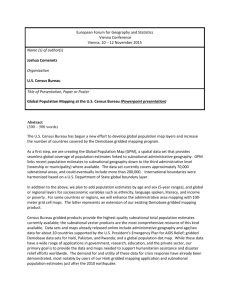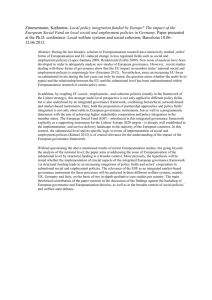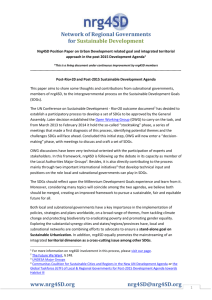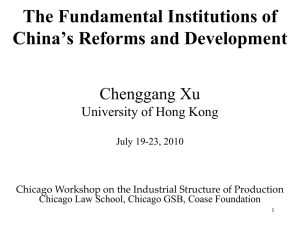OCR Document - ConstitutionNet
advertisement
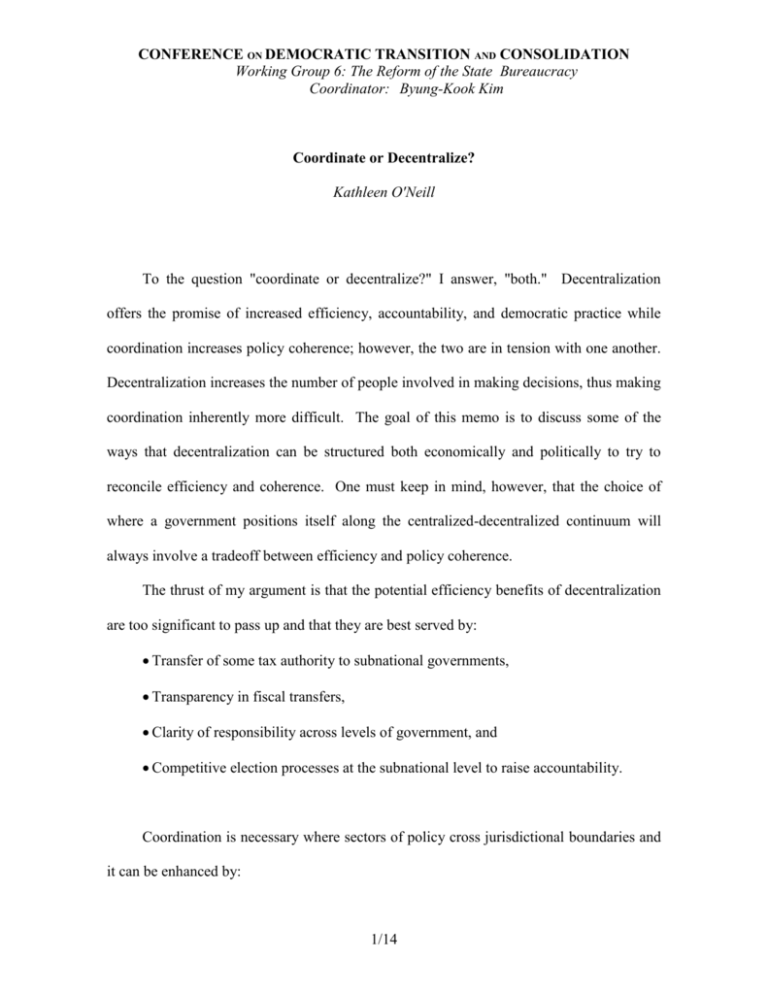
CONFERENCE ON DEMOCRATIC TRANSITION AND CONSOLIDATION Working Group 6: The Reform of the State Bureaucracy Coordinator: Byung-Kook Kim Coordinate or Decentralize? Kathleen O'Neill To the question "coordinate or decentralize?" I answer, "both." Decentralization offers the promise of increased efficiency, accountability, and democratic practice while coordination increases policy coherence; however, the two are in tension with one another. Decentralization increases the number of people involved in making decisions, thus making coordination inherently more difficult. The goal of this memo is to discuss some of the ways that decentralization can be structured both economically and politically to try to reconcile efficiency and coherence. One must keep in mind, however, that the choice of where a government positions itself along the centralized-decentralized continuum will always involve a tradeoff between efficiency and policy coherence. The thrust of my argument is that the potential efficiency benefits of decentralization are too significant to pass up and that they are best served by: Transfer of some tax authority to subnational governments, Transparency in fiscal transfers, Clarity of responsibility across levels of government, and Competitive election processes at the subnational level to raise accountability. Coordination is necessary where sectors of policy cross jurisdictional boundaries and it can be enhanced by: 1/14 CONFERENCE ON DEMOCRATIC TRANSITION AND CONSOLIDATION Kathleen O'Neill Imposing hard budget constraints, Strengthening national control within parties, A coordinating agency that shares information across levels of government, and A strong, autonomous central bank whose monetary policy constrains subnational governments. The Logic of Decentralization The appeal of fiscal federalism is the idea that, all else equal, subnational (regional, provincial, local) governments have informational advantages over a distant central government in knowing the bundle of local services desired by local residents. If people can move freely across local boundaries and congregate with others who share like preferences, and if local governments have incentives to be responsive to local residents, then local goods provision will be more efficient than central provision of those goods. Though the assumptions of this basic model are rarely met in practice, its basic logic has seeped into justifications for decentralization for several decades. Efficiency is greatly enhanced when local governments not only apportion money for local goods provision, but when they also must raise those funds so that they internalize the marginal costs of raising each additional unit of local finance. While this is theoretically elegant, in practice few local governments raise substantial resources; instead, transfers from the center support most subnational spending. In large part, the efficiency loss that central collection and subnational expenditure of funds occasions is offset by the economies of scale the central government enjoys over subnational governments in revenue collection. 2/14 CONFERENCE ON DEMOCRATIC TRANSITION AND CONSOLIDATION Kathleen O'Neill In addition, central collection and disbursement allows for greater redistribution of income across territory than subnational collection of resources. At the same time, many governments encourage subnational revenue collection to supplement transfers to increase the extent to which the marginal unit of resources spent is internalized by the subnational government. Highly competitive elections for subnational governments also provide increased transparency and efficiency at the subnational level, as well. Those who would challenge incumbents face strong incentives to keep close tabs on the practices of incumbents. Where selection of subnational governments is not competitive, rent seeking will rise. Pros and Cons of Different Types of Decentralization Decentralization can take many forms and I will begin by roughly dividing the possibilities into types: (Type 1) or centralization involves appointed subnational officials without substantial fiscal resources; (Type 2) election of subnational officials without substantial decentralization of fiscal resources; (Type 3) appointment of subnational officials with substantial decentralization of fiscal resources; and (Type 4) election of subnational officials along with substantial decentralization of fiscal resources. Centralized systems ignore the efficiency benefits outlined above. Neither categories 2 nor 3 is likely to increase efficiency of local goods production. In the first case (exemplified by Ecuador's decentralized system), elected officials with no real spending capability will be unable to provide local goods for which they are nominally responsible. They will either be forced to toe the central government's policy line in exchange for resources or they will face incentives to trade policy influence with local contractors to implement policies at odds with the central government. Not only do these options put a 3/14 CONFERENCE ON DEMOCRATIC TRANSITION AND CONSOLIDATION Kathleen O'Neill brake on policy innovation and efficiency gains, but they also increase distrust amidst the subnational electorate as officials either renege on campaign promises or engage in corruption. In the second case (exemplified by Chile under Pinochet), subnational officials who serve at the central government's pleasure, may increase efficiency by being responsive to their constituents to a point - but only to the extent that constituents' desires do not conflict with central government policy goals. Appointed officials have little autonomy to innovate or to disagree with the center. The fourth combination, political and fiscal decentralization, is the most likely to lead to efficiency gains, but it is also the most difficult to implement, since central governments would rather not give away substantial fiscal resources to subnational officials they do not control. This is particularly true when subnational politicians may fashion themselves as political rivals to the central government1. To the extent that governments seek efficiency benefits, moves toward type 4 decentralization will provide the best possibility of gains. Given that a government would like to move forward along this track and would like to maximize efficiency gains and coordination at the same time, what is the best way to proceed? I will touch on two economic topics before moving on to discuss political and institutional structures that might improve coordination. Structure of Fiscal Transfers and Responsibilities The conduit through which central-subnational affairs are most tightly connected is the stream of fiscal resources collected by the central government and distributed to the elected subnational government. The manner in which these resources are distributed is one of the most consequential ways that particular decentralizing arrangements differ and it 4/14 CONFERENCE ON DEMOCRATIC TRANSITION AND CONSOLIDATION Kathleen O'Neill is an arena of policymaking that is frequently renegotiated over time. Two dimensions along which differences arise are the formula for distributing transfers and the discretion of subnational government over spending these transfers. Transfer Formulas Each decentralizing government chooses a slightly different mechanism for transferring fiscal resources to subnational governments. In Bolivia for example, a large amount of resources is transferred purely on the basis of population, with another substantial degree of transfers dependent purely upon the administration's discretion. In Colombia, by contrast, a highly technical and multi-faceted formula that includes such criteria as the fiscal effort of subnational units governs these transfers. There are two aspects of transfers that I will discuss here: the extent to which they are discretionary and the exact items that make up the formulas for disbursement of non-discretionary transfers. To the extent that transfers depend upon the central government's discretion, a country drifts closer to Type 2 decentralization (with its concomitant problems). Under Fujimori, Peru's transfer system moved from a more formulaic to a more discretionary system, with the result that funds meant for impoverished areas were directed toward areas of most importance to Fujimori's re-election campaigns. A similar situation occurred in Mexico with PRONASOL funds under Salinas de Gartori. In general, formulaic transfers increase transparency and dependability; they expand the planning horizon of subnational governments who will be more able to predict future financial inflows from a knowledge of the formulas and thereby allow for the implementation of longer-term planning. 1 In fact, it is becoming increasingly common for subnationally elected officials to run for president or other national office on the basis of their record of governance as governor or mayor. 5/14 CONFERENCE ON DEMOCRATIC TRANSITION AND CONSOLIDATION Kathleen O'Neill While formulaic transfers are generally preferable to discretionary transfers, not all formulae are equal. Formulae that include needs-based criteria can help to redistribute resources more equitably across subnational units; formulae that include some measure of fiscal effort can increase efficiency by rewarding those subnational units that attempt to raise their own revenues in addition to using intergovernmental transfers. At the same time that including redistributive and effort-based criteria can improve transfers, simplicity of the formula has a value of its own by increasing transparency, the perception of fairness and the ability of subnational governments to anticipate future streams of transfers. Policymakers must weigh these tradeoffs when they establish or amend transfer formulae. Discretion in Spending Transfers Much has been written here about the levels of discretion enjoyed by the central government in apportioning fiscal resources. The central government can also control subnational government policy by limiting the uses to which subnational governments put transferred money. Where subnational governments are overly constrained in how they must spend transfers, they approximate the Type 3 decentralization discussed above. Constraints like Colombia's Law 60, which forces regional governments to spend 60% of one category of transfers on education, and 20% on health with only 20% discretionary may seem extreme. While many experts reject complete discretion because it makes coordination between levels of government difficult, others argue that spending mandates unduly restrict the responsiveness of local governments to their constituencies. Critics also argue that some projects may require large expenditures in one year in a specific sector while the following year may require larger expenditures in another sector so that there is an averaging out over the term toward the percentage spending goals and these particular 6/14 CONFERENCE ON DEMOCRATIC TRANSITION AND CONSOLIDATION Kathleen O'Neill goals make this type of long-term investment difficult. One possibility would be to increase national oversight for the programs that require coordination across different levels of government and for longer-term projects, but to increase subnational government spending discretion in as many other areas as possible. Discretion in transfers decreases efficiency; discretion in spending increases efficiency except where several levels of government share responsibility for a sector or where political contests for subnational officials are not highly competitive; read on for more on both of these cases. Clarity of Responsibilities Beyond the question of how to structure transfers and how to regulate their use is the related question of how to divide responsibilities between levels of government, particularly where power has been devolved to a number of different levels. In most systems (Bolivia, for example), different levels of government have overlapping responsibilities. Using education as an example, some systems give national governments responsibility for hiring and paying teachers, while local governments are responsible for teaching materials and regional governments are responsible for inputs like school construction and maintenance. Without strong coordination between these three levels in this example, one can imagine a large endowment of teachers coming to an inadequately small school with a large number of math books and no science books whatsoever. This kind of disorganization may sound comical, but it is frequent in Latin America, where clear lines of responsibility have rarely been laid out. More immediately consequential to the nation than disorganized education or health care is the fact that a lack of clear responsibilities often leads to overlap in spending by 7/14 CONFERENCE ON DEMOCRATIC TRANSITION AND CONSOLIDATION Kathleen O'Neill multiple levels of government, increasing the federal deficit. While increased violence surely accounts for some of Colombia's fall from economic grace in recent years, much of its rising deficit has been blamed on duplication of spending by national and subnational governments. In fact, a poll of those holding Colombian bonds conducted by Morgan Stanley to determine what issues most affect their confidence in Colombia's economic performance showed the top priorities were not related to public order but were instead the reform of intergovernmental transfers and of pensions2. Where politics revolves around patronage - as in most of the developing world responsibilities are often left unclarified at the time of reform as politicians at all levels resist limitations on their ability to impact programs such as health and education. Budget Constraints/Borrowing/Bail-Outs Finally, the financial issue which has received the most attention in recent years has been the importance of establishing hard budget constraints for subnational governments and avoiding national bailouts of regions or localities who have overextended themselves in debt markets. The key story to illustrate this point is the financial impact that bailouts of large states has had on the Brazilian economy and the important restructuring of federal relations that resulted. While Brazil has certainly been the most widely publicized case of this phenomenon, it is not the only place that has experienced it. Central governments face a difficult quandary when subnational units overspend: bail them out and send the signal to other subnational units that profligate spending will be rewarded with federal bailouts, or let them fail which could hurt the national economy, as well as the political fortunes of the parties at the center amidst the electorate in the subnational unit. The best option is to send 2 Reported in Semana magazine, Issue #995 ("La Paz en Ultimo Lugar"). 8/14 CONFERENCE ON DEMOCRATIC TRANSITION AND CONSOLIDATION Kathleen O'Neill a strong signal that bailouts will not be forthcoming in the future by refusing to bailout a large subnational entity or, perhaps, by increasing central bank independence. Political Structures and Coordination Not all answers to the question of how to coordinate decentralized government revolve around economics. Coordination can be improved on the political side through at least two mechanisms: allowing for the re-election of subnational governments and through strengthening party systems. Where mayors and governors are term-limited, their incentives to invest in long-term projects or to coordinate policies with the center are diminished; by lengthening planning horizons (even if only probabilistically), re-election should improve incentives to coordinate. Party organizations can play a major role in coordinating policies when subnational governors must adopt national party labels or where national party leaders strongly influence their subnational counterparts (through placement on the ballot or campaign finance, for example). If national party leaders have strong influence on the future careers of subnational governors, this can lead to easy coordination of policies between center and subnational units break the tendency of subnational governments to overspend and seek bailouts decrease the need for politicians in subnational units to rely on patronage. A final suggestion for increasing coordination across jurisdictions is to encourage the sharing of information across jurisdictions of what has been successful in some subnational units so that others could learn from the experimentation across units. The finance ministry could play a major role in this regard as it has frequent contact with subnational administrations through transfers and taxation policies. 9/14 CONFERENCE ON DEMOCRATIC TRANSITION AND CONSOLIDATION Kathleen O'Neill Sequencing Latin America provides a variety of experiences in the sequencing of decentralizing reforms. Chile decentralized financial resources under Pinochet but did not allow for popular election of subnational officials until after his rule ended; Ecuador has allowed for the election of subnational officials without giving them substantial financial resources; Colombia and Bolivia decentralized both political and fiscal resources simultaneously, through dramatic reforms; Venezuela and Mexico took a more gradual route, with Venezuela requiring subnational governments to petition the national government - and receive its approval - for greater decentralization once they can prove capacity (although popular elections determine subnational office holders). Where fiscal resources are decentralized without the popular election of subnational officials, decentralization does not gain the strong support of constituents, as they may see no signs of change and incentives for appointed officials to increase subnational efficiency are low. Where fiscal resources lag behind political resources, politicians may engage in corrupt practices to gain scarce resources, delegitimizing the decentralization process in the longer term. The best outcome is to decentralize both, simultaneously or in close succession. Decentralizing the political side alone will almost always lead to fiscal decentralization in the longer term, so I would suggest this as a second-best solution. Interest Intermediation: Should the state try to build a particular mode of interest intermediation with business associations and labor federations? My experiences offer no clear answer and experts offer different suggestions on how to address this question. Some argue that a state insulated from society provides the most effective coordination of policies. Others argue that societal 10/14 CONFERENCE ON DEMOCRATIC TRANSITION AND CONSOLIDATION Kathleen O'Neill groups and organizations are the channels through which the state coordinates policy and that, without an effective system of interest intermediation, heads of state will be unable to mobilize resources, coordinate policy, and implement decisions. In most cases, interest groups will adapt to their environment and the center is limited in its capacity to shape interest groups. Where decision making over relevant issues to these groups is centralized, they will organize to pressure the government at the center; where decision making is decentralized, they will follow suit. Some of the greatest resistance to the decentralization of policy making in Latin America has been led by teachers' unions, who have built highly centralized structures for bargaining over salary at the center. Given their centralized structure and strength, they are loath to see decision-making devolved, requiring them to negotiate with numerous subnational governments. At the same time, the idea that social organizations may play a major role in helping decentralized levels of government coordinate with one another has theoretical strength; however, the ability of social organizations to play this role depends on the homogeneity of the group, its ability to organize and coordinate across its own decentralized structure, and its overall capacity to gather information and interact with the government. Policies that have been shaped and coordinated through interest groups interactions with government are bound to be more easily implemented and, at least as far as the particular interest group is concerned, more popular. 11/14 CONFERENCE ON DEMOCRATIC TRANSITION AND CONSOLIDATION Kathleen O'Neill Executive Summary Decentralization offers the promise of increased efficiency, accountability, and democratic practice while coordination increases policy coherence; however, the two are in tension with one another. The potential efficiency benefits of decentralization are best served by: Transfer of some tax authority to subnational governments - This forces subnational governments to internalize the costs of their spending programs Transparency in fiscal transfers - Simple formulae are least likely to breed corruption; constituents find them easier to follow and, therefore, more transparent - More complicated formulae allow governments to target such priorities as redistribution, fiscal effort and other goals Clarity of responsibility across levels of government - This avoids duplication of spending by many levels of government - This avoids shirking of responsibility for basic services by all levels of government who blame the absence of services on another level 12/14 CONFERENCE ON DEMOCRATIC TRANSITION AND CONSOLIDATION Kathleen O'Neill Competitive election processes at the subnational level - This raises the accountability of subnational policy makers to their constituents - This raises the efficiency of local goods provision due to competition for stewardship of the subnational government Coordination can be enhanced by: Imposing hard budget constraints - This avoids overspending at subnational levels in hope of bailouts - This allows the central government to engage in long-term fiscal planning Strengthening national control within parties - This provides discipline to subnational government leaders - This lengthens the time horizons of subnational leaders Sharing information across levels of government - Allowing governments to learn from successes and failures of peers - Raises expectations of constituents for better performance A strong, autonomous central bank whose monetary policy constrains subnational governments. - Maintains central control of monetary policy 13/14 CONFERENCE ON DEMOCRATIC TRANSITION AND CONSOLIDATION Kathleen O'Neill 14/14
